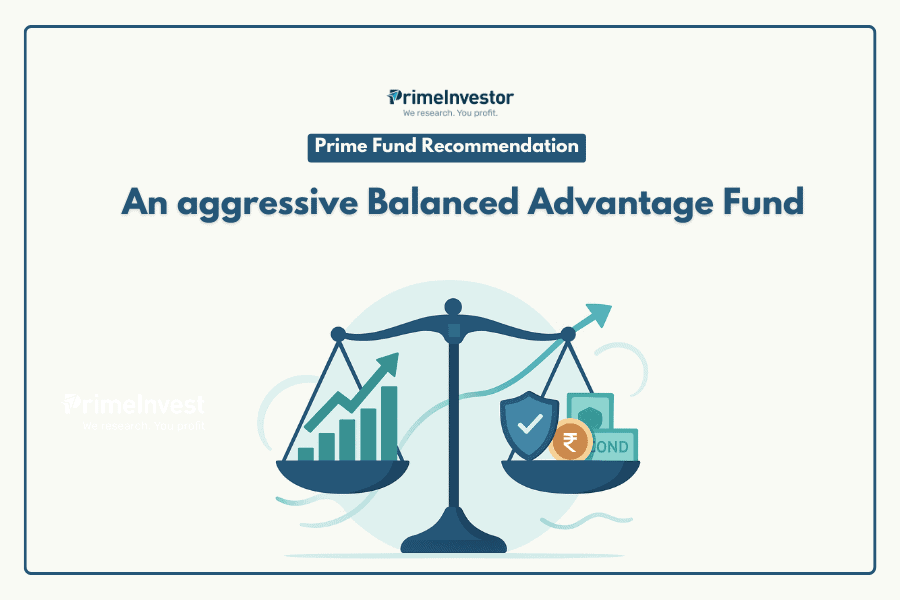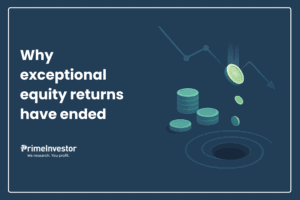While equity offers the best potential for long-term returns, it also comes with a possibility of short-term losses. The appeal of Balanced Advantage Funds is that they can reduce losses without severely compromising returns.

We take a fund in this category which has managed this balance remarkably well over the last five years and which has been part of the Prime Funds list for several quarters now: HDFC Balanced Advantage Fund. Despite undergoing a change in its management, it remains a top-performing fund in the category and is also among the most popular funds in the Indian mutual fund space, with assets of over Rs.1 lakh crore. Let’s dig deeper into why this fund deserves your attention.
What are Balanced Advantage Funds?
SEBI formally recognized Balanced Advantage Funds (BAFs) as a category in its mutual fund reclassification exercise, effective April 2018. These funds, also known as Dynamic Asset Allocation Funds, can theoretically shift their equity allocation anywhere between 0% and 100%, with the balance invested in debt or arbitrage exposures. Arbitrage yields debt-like returns and is typically used to maintain the fund’s equity taxation status.
BAFs raise or lower equity exposure based on their reading of markets, using indicators such as price-to-book ratio, price-to-earnings ratio, equity market momentum, and earnings yield-to-bond yield spreads. Each fund in the category has its own set of metrics and therefore allocations between funds are always different.
Most Balanced Advantage Funds aim for equity taxation by keeping the combined equity and arbitrage allocation at or above 65% of assets. However, some newer funds are targeting a 35% to 65% equity + arbitrage range, taking advantage of recent tax rules that allow long-term capital gains from such funds to be taxed at 12.5% after a holding period of two years. (By contrast, equity funds are taxed at 12.5% after one year).
HDFC Balanced Advantage portfolio changes
HDFC Balanced Advantage was managed by star fund manager Prashant Jain until July 2022. Earlier, the fund was known as HDFC Prudence Fund and was a vanilla balanced fund with an equity allocation of more than 65% and no derivative exposure.
After SEBI’s reclassification exercise (2018) restricted fund houses to just one scheme per category, HDFC Prudence Fund was moved to the Balanced Advantage category. Even after this shift though, Prashant Jain continued to run the fund as a normal hybrid fund without derivative exposure.
After Jain’s exit in July 2022, Gopal Agrawal took charge of the equity portfolio, with Anil Bamboli managing debt. The fund then transitioned into a true Balanced Advantage structure, with Srinivasan Ramamurthy appointed to oversee asset allocation. Later, Arun Agarwal (October 2022) and Nandita Menezes (March 2025) joined the fund management team.
The asset allocation manager sets monthly allocation levels based on earnings yield, bond yield, and trailing PE ratio. The equity manager is allowed a 5% band around the advised level. The balance goes into debt and arbitrage. To maintain equity-oriented taxation, any sub-65% equity exposure is supplemented with arbitrage positions.
The fund’s equity allocation has shifted significantly since mid-2022, falling from ~78% to an average of 55% over the past year. In September 2024, when markets peaked, equity exposure dropped to its lowest at 49.2%. Since then, the fund has gradually added equities, reaching 60.25% in July 2025, above the category average of 57.6%. This dynamic adjustment shows the fund aligning to the Balanced Advantage mandate. It has also been getting these calls right so far.
Jain’s trademark investing style was to identify and exit expensive sectors ahead of time while taking contrarian calls on out-of-favour themes. Therefore, the fund leaned heavily towards value stocks during Jain’s tenure, causing underperformance until 2020, as his PSU picks remained laggards. However, when these stocks rebounded in 2021, the fund delivered stellar returns, outpacing peers for two years.
Post the management changes, the portfolio has been reshaped but retains the value tilt. The fund’s portfolio is allocated towards large caps and currently looks as follows
- Sector allocation: Financials (19%) and technology (9%) are in line with category averages, though the fund is overweight on energy at 8.2% vs 5.4% for peers.
- Diversification: The fund holds over 140 stocks (as of July 2025). Only HDFC Bank exceeds a 5% weight (5.53%). Other top holdings: ICICI Bank (4%), Reliance (3.2%), Bharti Airtel (3.2%), SBI (2.7%), and Infosys (2.7%). The top 10 stocks account for ~30% of the portfolio.
- Portfolio changes: The fund has seen minimal churn in the past year; top allocations are largely unchanged. The technology sector saw increased exposure, while Energy was slightly reduced.
On the debt side, the fund holds over 300 securities, mainly in high-rated AAA corporate bonds (17.6%), government securities (9.3%), and cash equivalents (10.6%). The fund avoids credit risk but takes on duration risk, maintaining an average maturity above seven years. As of July 2025, the fund’s Yield to Maturity stood at 6.67%, above prevailing government bond yields at that time, thanks to its higher corporate bond exposure.
Why Buy?
HDFC Balanced Advantage suits investors who are not entirely comfortable with pure equity funds without a severe compromise on returns. It can also work for medium-term goals (3–5 years), where pure equity funds may be too risky. Within the Balanced Advantage category, HDFC Balanced Advantage Fund has consistently delivered superior performance, outpacing both peers and even indices with more equity exposure. Let’s look at the details. All returns are from the fund’s category reclassification; 2018 April 1st.
As is evident from both one-year and three-year rolling returns, the HDFC Balanced Advantage fund has beaten the category and a steady-state 65-35 index comfortably on returns. However, the low minimum returns and high standard deviation indicate that it sees sharp short-term swings in returns and higher downside risk, to earn these returns. The lowest 1 year returns of the fund, at -30.21% is about double the loss of lowest 1 year return for the category. This is not surprising, given that HDFC Balance Advantage was, for a long time, by far more aggressive than peers with minimal hedging.
The fund clocks a better performance over the longer term with its lowest 3 year rolling returns better than the category and reference index; but even in these longer-term periods, its volatility is still higher.
Instances of losses: The fund also slipped into losses more frequently, again owing to higher equity exposure. On a 1-year basis, HDFC Balanced Advantage delivered losses about 12% the time, versus only 4.3% for the category average. Over three-year rolling periods, however, neither the fund nor the category average has seen losses.
The above characteristics may make the fund less suited to investors who are seeking to avoid losses and expect steady returns from the BAF category. Such investors may need to look at the other Prime Fund in the category (housed under Hybrid – Low Risk), ICICI Pru Balanced Advantage, which has lower deviations and more dynamic hedging.
Performance in Bull and Bear markets
To assess how HDFC Balanced Advantage fares across market cycles, we also looked at its performance across three bear markets and three bull markets.
The fund was among the hardest hit during the COVID crash but has since shown resilience, containing losses better than peers and the reference index in subsequent downturns.
The fund has consistently topped the charts in rallies, outperforming the category by 10–25% in the first two bull phases. In the latest bounce (since March 2025), where markets have yet to show a clear uptrend, it has kept pace with the category and the reference benchmark index.
Fund Expenses: The fund’s direct plan expense ratio of 0.74% is slightly above the category average of 0.68%. The regular plan, on the other hand, has an expense ratio of 1.34%, which is lower than the category average of 1.96%. The expense ratio differential, difference between direct and regular plan expense, at 0.6 percentage points is less than the category average expense ratio differential of 1.28%.
Fund Taxation: The fund maintains a gross equity allocation of 65%, hence is subject to the equity taxation. Short term (less than 1 year) capital gains are subject to 20% tax. The long term (1 year or more) capital gains will be taxed at 12.5% with gains upto Rs.1.25 lakh exempted.
Risks and Suitability
Balanced advantage is not a homogenous category where all funds deliver similar results. HDFC Balanced Advantage Fund is among the riskiest in the category – whether in the history of losses, extent of volatility, or even how it has structured its debt part of the portfolio. However, it has made up for the high risk with high returns. It does very well in bull markets, rivalling the returns of pure equity funds.
Although the fund has been getting better at containing losses in the downtrending markets, its speciality is making the most of the bull market rallies. This is important to note in the current market context where downside risks are elevated. This fund is not for conservative investors who are looking for debt plus returns with a minimal chance of losses.




9 thoughts on “Prime Fund Recommendation: An Aggressive Balanced Advantage Fund”
With due respect, this article/review is as confusing as this category in general and this fund in particular.
This is not the level of research we expect from PI team. BAF as a category is not expected to generate high returns, then why are we impressed with this fund’s returns?? BAF as a category is expected to protect downsides and reduce volatility – which this fund fails to do. Your article mentions that It’s only been a couple of years since the fund actually started working as a BAF, then why are you analysing data from 2018 ?? I don’t know a single use case of this fund! Even within the PI prime funds, there are far better funds if you want wealth creation, there are better funds for downside protection, for low volatility and also BAFs !!
Hello Sir,
Thank you for sharing your opinion.
To explain, BAFs (and other hybrid categories, for that matter) are somewhat tricky options – they don’t directly fit into all portfolios unlike pure equity or debt funds. They suit only specific use cases – and for BAFs, it is to allow equity exposure without the full equity risk.
When we make recommendations, we try to cover a range of funds that can be useful to an investor’s portfolio, even if not universally applicable. The HDFC BAF fund is part of Prime Funds.
HDFC BAF has been part of the SEBI-defined balanced advantage category since April 2018. There is no specified rule on what allocations should be to derivatives, for the category. So just because a fund does not follow the general norm that other funds do, it does not mean it shouldn’t be looked at.
That said, such deviations do contribute to the inputs we consider when making a subjective analysis and a recommendation. Which is also why we have both low-risk and moderate-risk hybrid in Prime Funds, and there is BAF in both sets 🙂
We have highlighted the risks specific to HDFC BAF, its suitability, and explained why treating all BAFs as homogeneous will not work. We had for a long time avoided adding HDFC BAF to Prime Funds because it was extremely high risk – we added it after it changed strategy. Our view is that it has changed for the better and now fits the use cases we have outlined. Of course, we will continue to monitor all our recommendations and will be ready to change our views if warranted. 🙂
Hope this clarifies the rationale behind our recommendation.
Best regards
Thanks for detailed feedback.I have debt portfolio in place It is 70% of my assets incd 12 Months expense in Bank a/c (3 M)plus liquid fund (9M). I am looking at equity portfolio only where I am holding BAF -ICICI Prudential for last several years. To ensure that equity portfolio remains at 30%, I need to invest some amount. I treat BAF as 100%equity only and not in ratio of equity/debt holding to be on safer side.
IN case of emergency, I am not required to touch my equity portfolio. Currently my BAF is at 20% of my equity holding,.
Question is further investment should be in ICICI BAF or i should diversify by investing in HDFC BAF.Some where many months back I had read (mostly on your platform only) that different BAF follow different algorithm and hence it may be better to have more than one BAF. My query is in this context. Are HDFC and ICIC follow same algorithm or diff? Would it make a good combination. My risk appetite can be taken as moderate . If you can now clarify/help
Hello Sir,
It is true that different BAFs use different approaches to decide their asset allocation. While they do mention their approach on a surface level, it is not possible to estimate future asset allocation from it by a third party.
By looking at the net equity allocations of these funds for the past year, there is a significant difference. While HDFC BAF did maintain a higher average equity allocation (55%) compared to ICICI Pru BAF (47%), there were times when ICICI Pru BAF’s net equity allocation was a few percentage higher than HDFC BAF’s. As of July 2025 portfolio, HDFC BAF’s net equity allocation stands at 60.25% vs ICICI Pru BAF’s 47.19%.
Best regards
Hi Team,
can you please write about zerodha multi asset passive fof ?
If One has ICICI balanced adv fund in folio, should one invest in this for diversification or continue to invest in ICICI further amount?
Hello Sir,
As mentioned in the article, BAFs differ in their risk levels. HDFC BAF is a high risk fund, while ICICI Pru is a low risk fund in the BAF category. This is the reason we’ve classified those in separate Prime Funds categories. Depending on your investment horizon and risk appetite, you may decide to add HDFC BAF. Please refer to the Role in your portfolio mentioned against both of these funds in the Prime Funds page.
Thanks
Given the risk factors, it looks like timing the entry becomes important, specifically if one is making a lump sum investment for medium-term (3–5 years) goals.
I think that a BAF is more suitable to collect funds for one specific goal (or for more than one goals with similar importance/urgency levels and differing only in the timelines), rather than as a part of a long-term portfolio.
In a long-term portfolio, depending on the proportion allocated to the BAF, the changes in net equity levels may not matter as much on the whole portfolio level. I assume you wouldn’t suggest creating a portfolio that entirely or majorly consists of BAF?
Hello Sir,
Creating one’s entire portfolio with BAFs will be risky. Even if the aim is to reduce risk by not investing in pure equity funds. In the event of any unexpected cash requirements that need a partial redemption from the portfolio, BAFs will force the investor to redeem both equity and debt. Depending on the prevailing market conditions, this may or may not be ideal. Having separate debt funds will give more options in this case.
Thanks.